When I started working on my culinary arts degree in 2018 one of my main goals was to learn HOW TO MAKE RAMEN. I wanted to recreate the deep rich flavorful broths I had experienced in Japan.
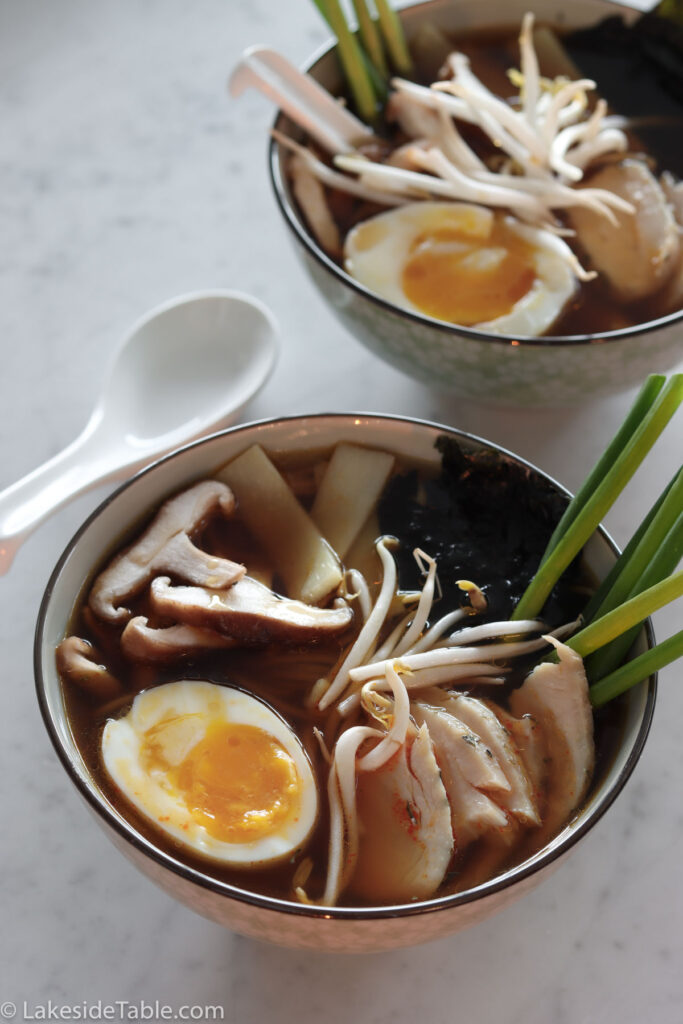
Being able to serve these deep earthy tones with all the gorgeous toppings to my family right here in the Midwest heartland is a real treat.
Table of contents
BASIC RAMEN RECIPE (shoyu style)
This is an easy homemade ramen noodle soup that reminds me so much of my visits to Tokyo and Kyoto. One of the key elements you don’t want to overlook is roasting the chicken wings in the oven. This gives the chicken broth a deep flavor that makes a huge difference!
Ingredients
For the Broth
- 6 pounds of chicken wings
- 8 medium carrots peeled, cut into 1-inch rounds
- 15 scallions roots removed
- 10 cups water
- 1 head garlic, remove the outer paper and roots cut in half
- 2 inches fresh ginger peeled and cut into 1-inch segments
- 2 ounces dried shiitake mushrooms
- 2 sheets of dried kombu 6 inches each
- 1/4 cup soy sauce low sodium
- 1 1/2 ounce dried bonito flakes
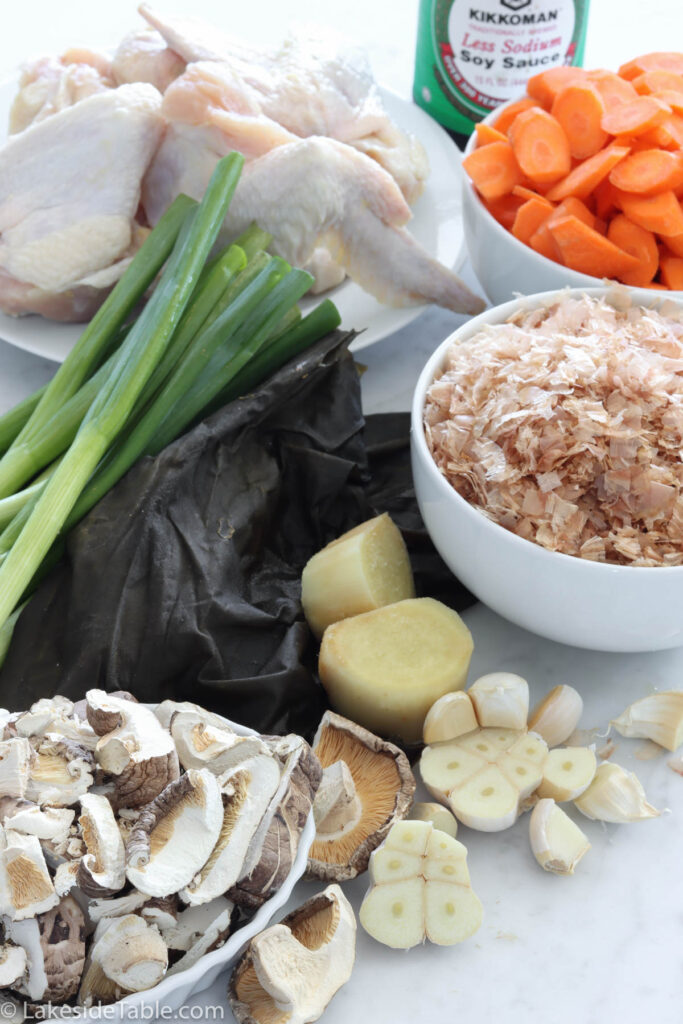
Finishing sauce (shoyu tare)
- 1/4 cup soy sauce low sodium
- 2 tablespoons mirin
Noodles & Eggs
- 2 soft-boiled eggs (6-minute egg) peeled
- 4 bundles of soba noodles (each bundle: 5 ounces)
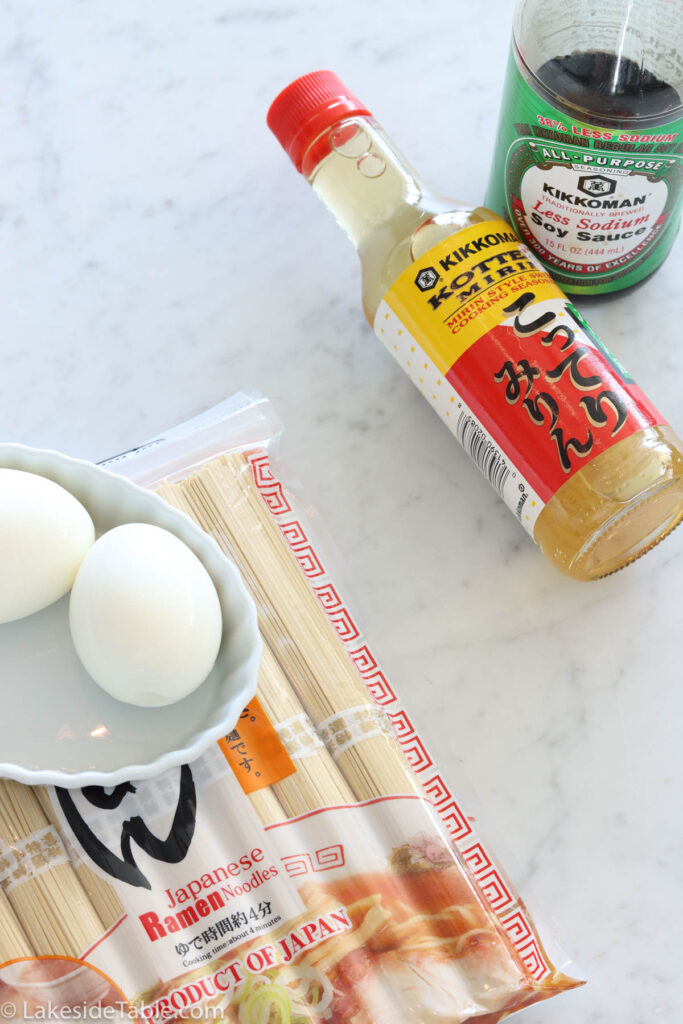
Toppings
- 6 scallions sliced into thin rings
- 1/2 cup fermented bamboo shoots
- 4 sheets dried nori cut into thin strips
- 4 teaspoons Japanese garlic paste
- Toasted sesame oil
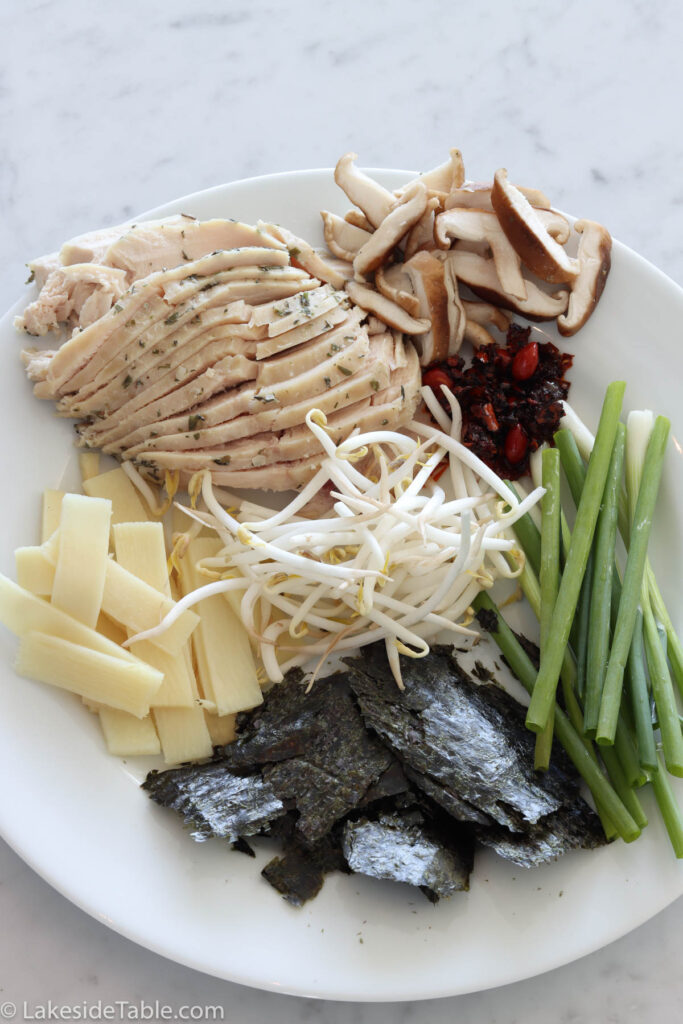
Instructions
Make the Chicken Stock
- Preheat oven to 425F.
- Place chicken wings in a stovetop-safe roasting pan and roast in the oven for 30 minutes. Reduce heat to 350 degrees and mix carrots and scallions with chicken wings. Roast for another 20 minutes.
- Transfer roasted chicken wings and vegetables to a soup pot. Deglaze the roasting pan with 2 cups water over low to medium heat on the stove. Scrape all bits off the roasting pan with a wooden spoon. After the pan is clean and the water is boiling, pour it all into the soup pot.
- Add garlic and ginger, kombu, mushrooms, bonito flakes, and the remaining 8 cups of water to the soup pot. Bring to a boil and then immediately lower the temperature to simmer.
- Simmer uncovered and skim any fat and scum that float to the top for 3 1/2 hours.
- Strain the broth through a fine mesh strainer. Discard all solids. Cool, cover, and refrigerate overnight. Before reheating, skim off any fat on top.
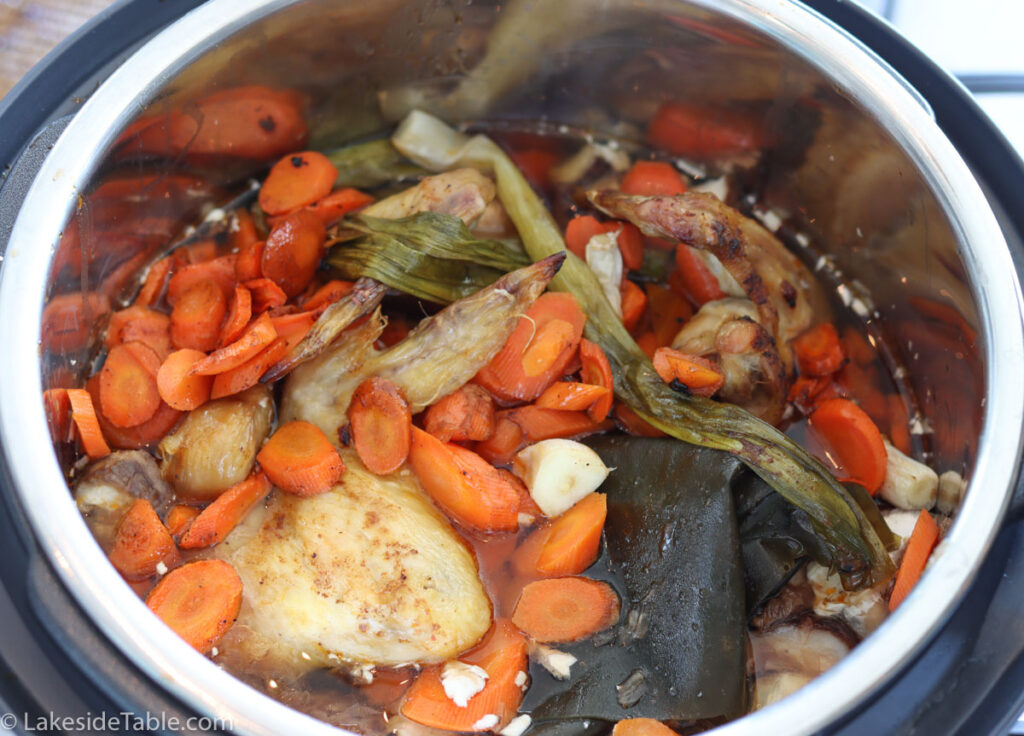
Make the finishing sauce
- Combine the soy sauce and mirin in an air-tight container and refrigerate until ready to use.
Ready to EAT!
- Noodles – Cook the noodles in salted water for 4 minutes; Peel soft-boiled eggs and slice in 1/2 long ways.
- Broth – bring the broth to a simmer in a saucepan. Add soy/mirin combo to taste.
- Assemble the ramen bowls – Divide the noodles among 4 bowls. Ladle broth over noodles.
- Place a half egg in each bowl. Top with bamboo shoots, scallions, nori, and crunchy garlic paste. Then drizzle with toasted sesame oil.
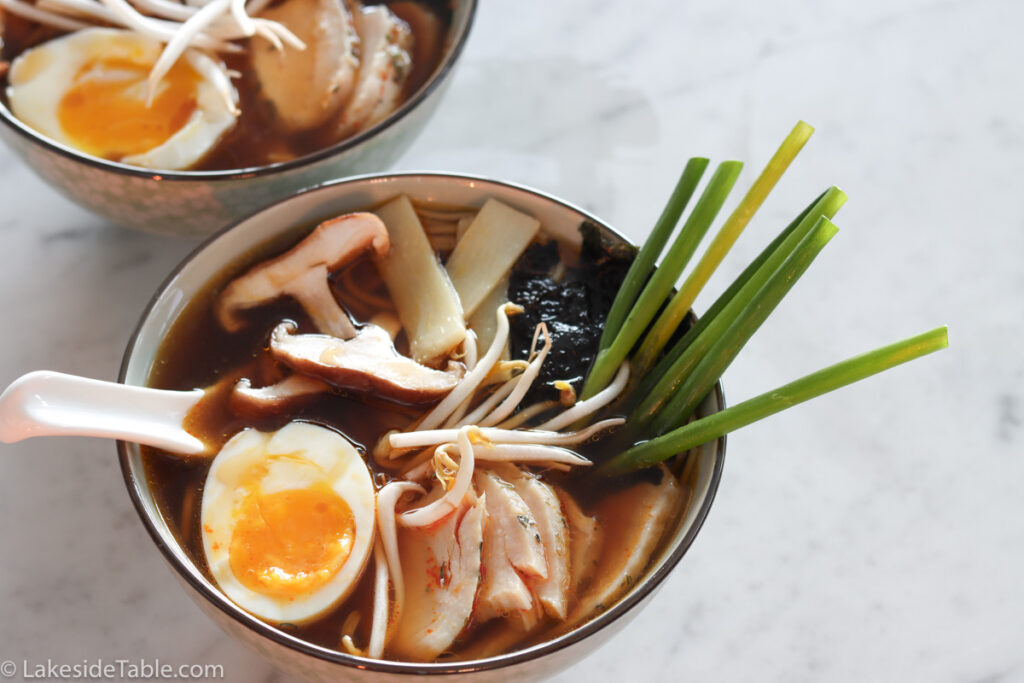
Disclaimer
I want to be perfectly clear…
I am not a Japanese ramen expert.
This is a culinary art form that people spend their entire lives dedicated to perfecting. I have complete respect for them and find myself in a perpetual state of awe of their artistry and commitment.
This recipe is a close echo of the mastery you find in Japan. It uses a few techniques I learned in school that pull out a lot of incredible flavors. Plus, it’s FUN to make and tastes incredible!
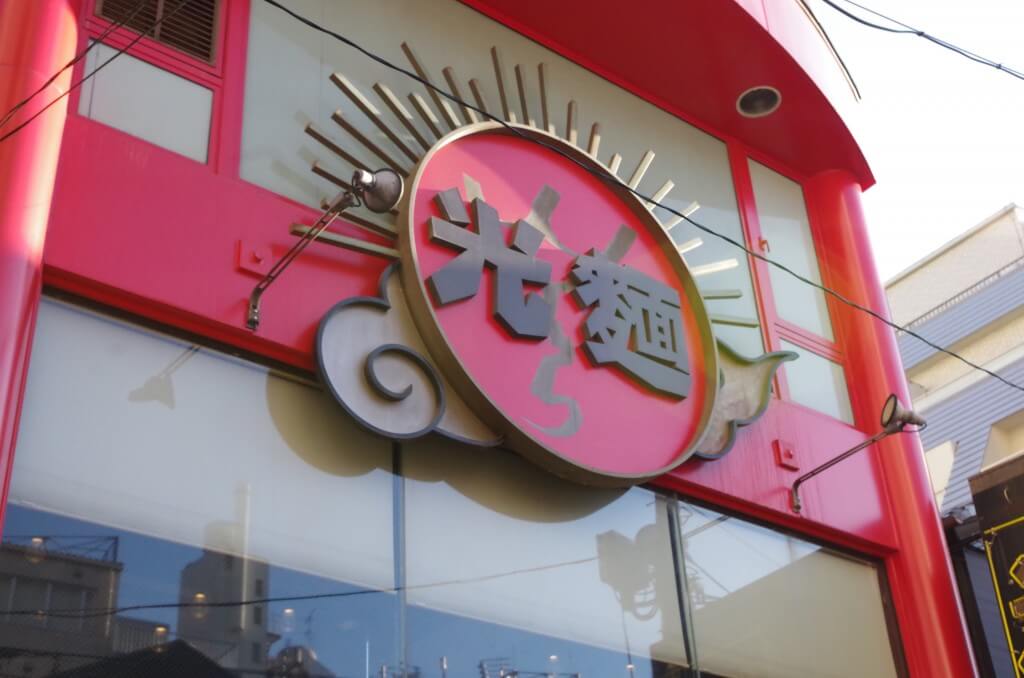
Types of Ramen
Ramen can have either sliced beef, pork, or chicken added to them along with various other toppings. These toppings include (but not limited to) preserved bamboo shoots, leeks, green onions, bean sprouts, soft-boiled egg, seaweed, fish cake, corn, and butter.
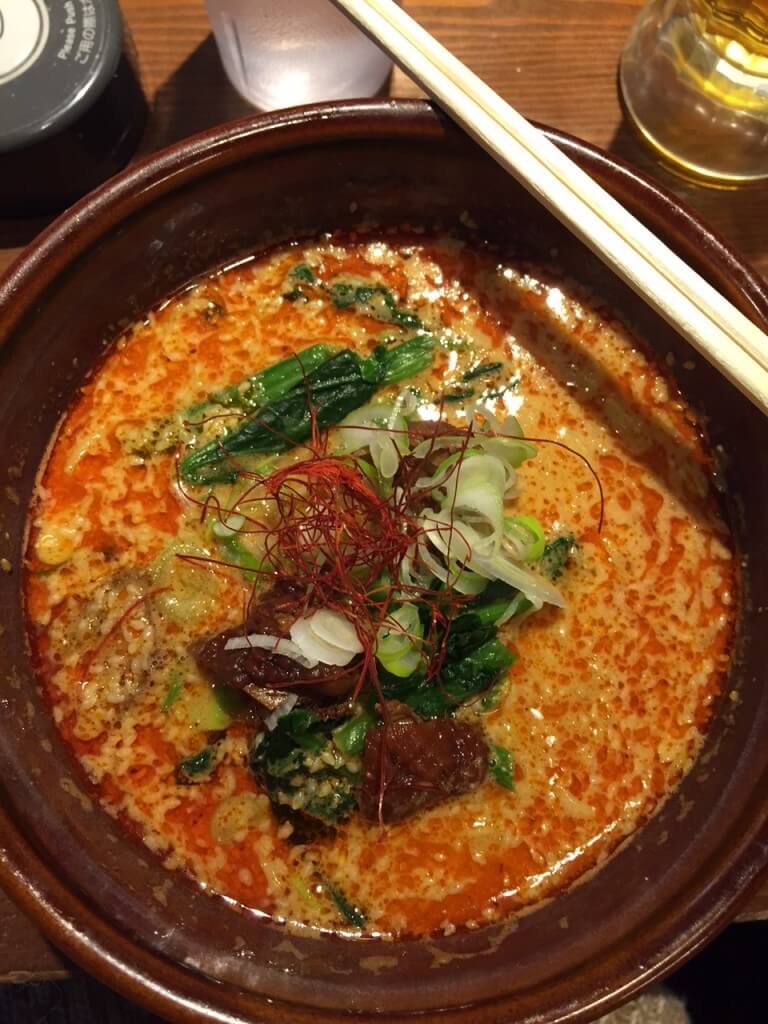
SHIO RAMEN – Shio means salt in Japanese and this type is usually light and clear. Many times it’s made with chicken bones, dashi stock, and bonito flakes.
TONKOTSU RAMEN – Tonkotsu comes from the Asakusa region and it has a deeply rich flavor that’s slightly sweet because it’s made from boiling pork bones for hours. The broth has a creamy cloudy look to it and smells divine.
MISO RAMEN – This ramen has a savory broth and comes from the Sapporo region of Hokkaido. As you can guess by the name, the main ingredient is miso. However, there are quite a few varieties of miso that can be used – white miso, barley miso, soybean miso, and red miso.
SHOYU RAMEN – Shoyu in Japanese means soy sauce. This is the predominant flavor in this ramen broth, tangy and salty. This is one of the most popular broths and is thought to be the original ramen. The recipe in this post is a type of shoyu ramen.
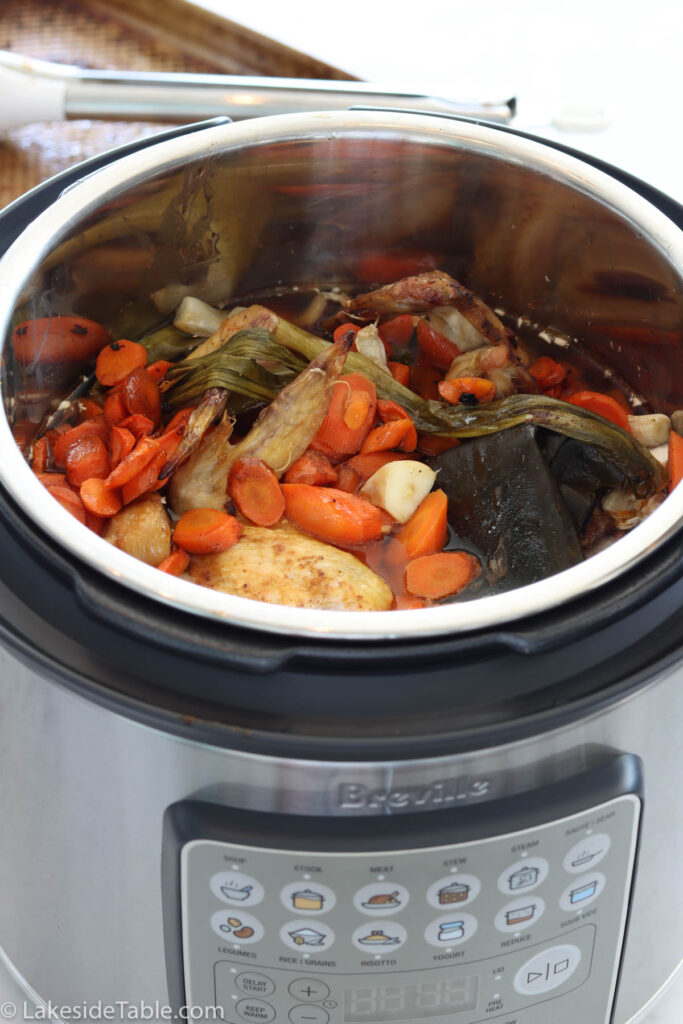
How to Cook Ramen in an Instapot
- After roasting the chicken wings and veggies in the oven, put all the broth ingredients in the Instapot or pressure cooker.
- Set it on mid-high pressure for 45 minutes.
- Set it for natural release.
- Strain the broth with a colander and then strain again through a fine mesh sieve.
- Use this as your broth base and continue with the rest of the instructions outlined above.
Ramen Noodles
First of all, get the plastic-wrapped $1 instant crap you lived on in college out of your head. What I’m talking about it is true ramen.
These noodles come in a variety of sizes and shapes, but they are traditionally made by hand with wheat flour, water, salt, and kansui. Kansui is a special type of alkaline water that gives the noodles their one-of-a-kind flavor, yellowish color, and bouncy texture.
Ramen means ‘pulled noodles’ and are traditionally made exactly as its name suggests. A huge mound of dough is stretched and folded repeatedly until miraculously the noodles are formed.
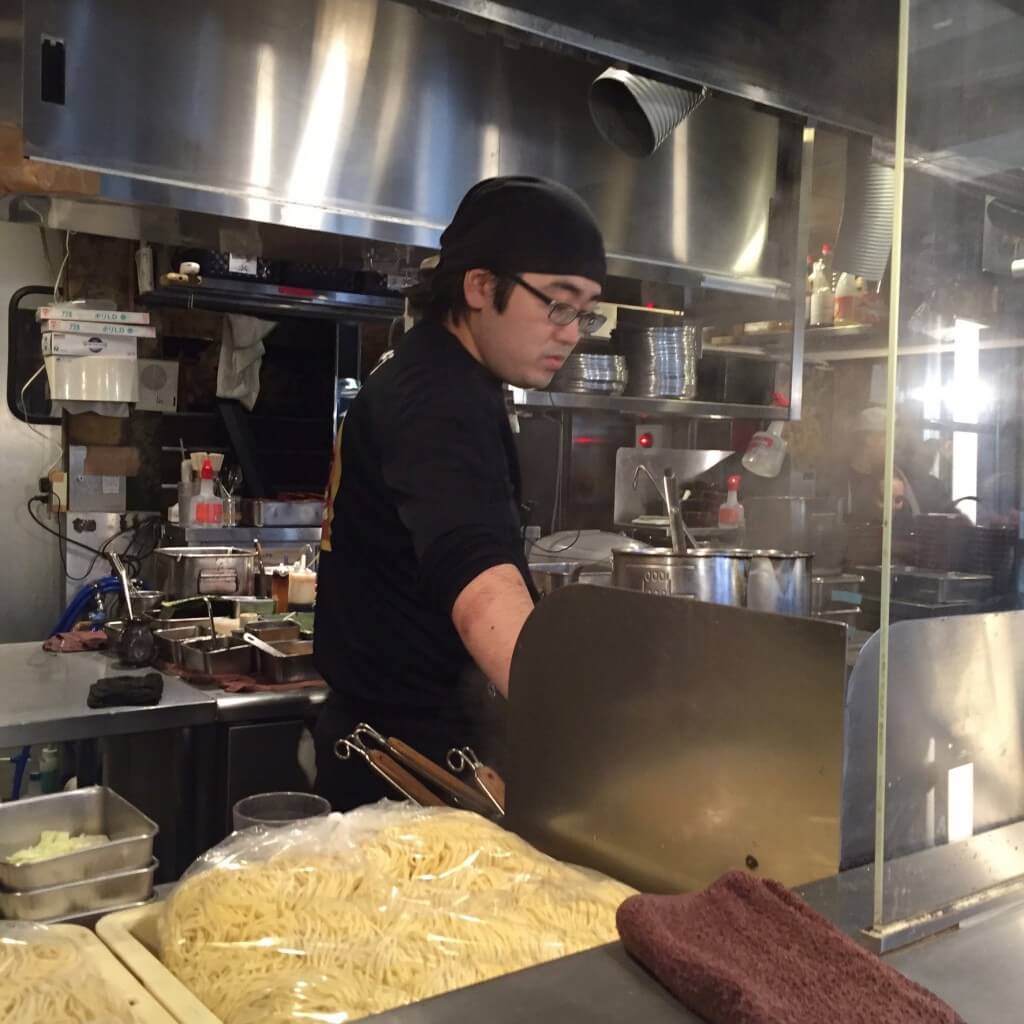
Unfortunately, we don’t have a professional noodle stretcher in our neighborhood so I usually opt for soba noodles. I recommend you choose your favorite too.
Ramen Ingredients & Toppings
Many of these ingredients were new to me and difficult to find in our small town. Fortunately, I was able to order them online or pick them up from one of our nearby (only 1-2 hours away) larger cities.
What is Kombu? This is a seaweed from the kelp family. It adds umami flavor and is highly nutritious.
What are Bonito Flakes? Also known as katsuobushi and are dried, smoked, fermented fish flakes. They’ve got a light salty smokey taste.
What is Mirin? If you do any Japanese cooking, this should be in your pantry. Mirin is a sweet rice wine that balances many of the salty flavors in other ingredients.
What are Nori sheets? These are seaweed sheets commonly used when making sushi rolls.
Other toppings to try
- Menma – fermented bamboo shoots
- Green onions
- Pickled ginger
- Chashu – thin slices of barbequed pork bell
- Pickled plum
- Kikurage – wood mushroom
- Toasted white or black sesame seeds
- Soy sauce or Tamari
Roll up your sleeves and enjoy playing with these ingredients. If you’ve never had a hearty authentic bowl of ramen before, you are in for an eye-opening experience you’ll love and won’t soon forget.
Itadakimasu!
(I eat this with respect and gratitude)
Other Asian Recipes
Moo Goo Gai Pan
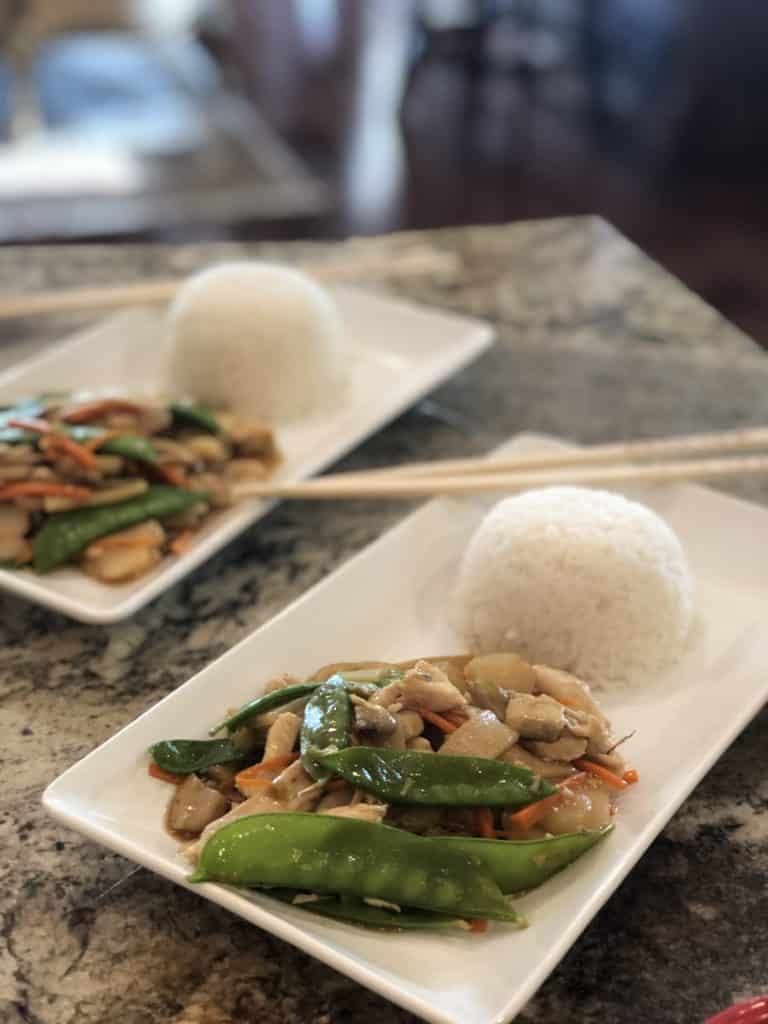
Red Curry Soup
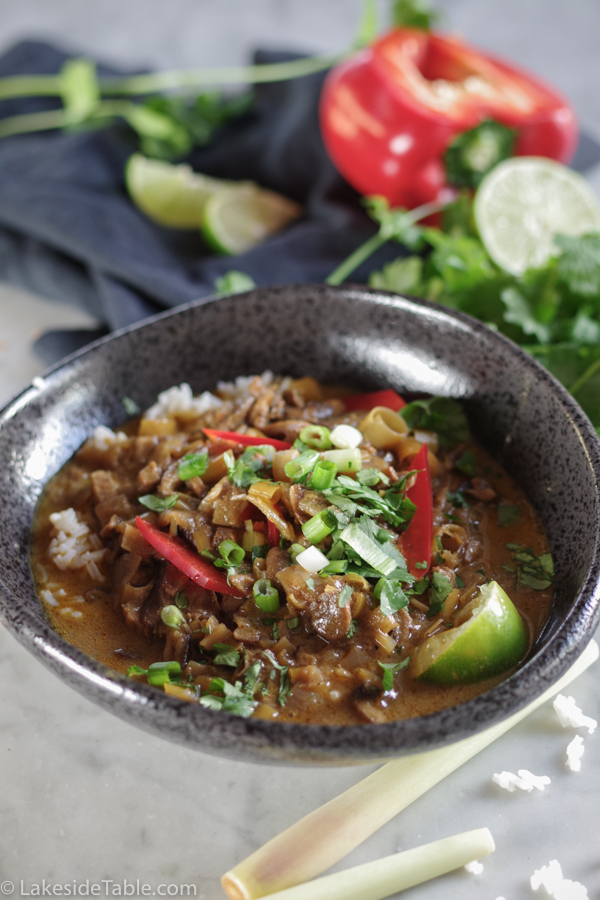
Thai Meatballs
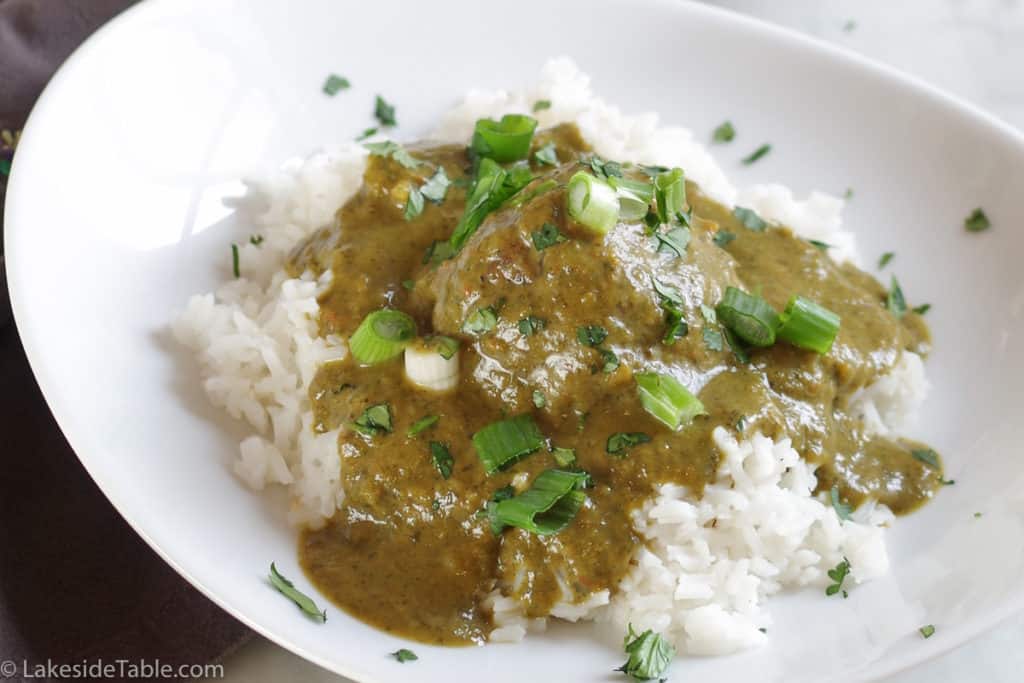
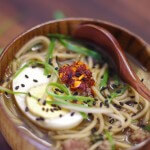
How to Make Ramen
Roll up your sleeves and enjoy playing with these ingredients. If you’ve never had a hearty authentic bowl of ramen before, you are in for an eye opening experience you’ll love and won’t soon forget. | www.lakesidetable.com
Ingredients
For the Broth
- 6 pounds chicken wings
- 8 medium carrots peeled, cut into 1 inch rounds
- 15 scallions roots removed
- 10 cups water
- 1 head garlic, remove outer paper and roots cut in half
- 2 inches fresh ginger peeled and cut into 1 inch segments
- 2 ounces dried shiitake mushrooms
- 2 sheets dried kombu 6 inches each
- 1/4 cup soy sauce low sodium
- 1 1/2 ounce dried bonito flakes
Finishing sauce (shoyu tare)
- 1/4 cup soy sauce low sodium
- 2 tablespoons mirin
Noodles & Eggs
- 2 soft boiled egg (6 minute egg) peeled
- 4 bundles soba noodles (each bundle: 5 ounces)
Optional Toppings
- 6 scallions sliced in thin rings
- 8 ounces chicken breast thinly sliced
- 1/2 cup bamboo shoots
- 4 sheets dried nori cut into thin strips
- 4 teaspoons Crunchy Chili Oil
- Toasted sesame oil
- Bean Sprouts
Instructions
Make the Broth
-
Preheat oven to 425F.
-
Place chicken wings in a stovetop safe roasting pan and roast in the oven for 30 minutes.
-
Reduce heat to 350 and mix carrots and scallions with chicken wings. Roast another 20 minutes.
-
Transfer roasted chicken wings and vegetables to a soup pot.
-
Deglaze roasting pan with 2 cups water over low to medium heat on stove. Scrape all bits off the roasting pan with a wooden spoon. After pan is clean and water is boiling, pour it all into the soup pot.
-
Add ginger, garlic, kombu, mushrooms, bonito flakes, soy sauce, and the remaining 8 cups of water to the soup pot. Bring to a boil and them immediately lower temperature to simmer.
-
Simmer uncovered and skim any fat and scum that float to the top for 3 1/2 hours.
-
Strain the broth through a fine mesh strainer. Discard all solids. Cool, cover and refrigerate over night. Before reheating, skim off any fat on top.
Make the finishing sauce
-
Combine the soy sauce and mirin in an air tight container and refrigerate until ready to use.
Ready to EAT!
-
Noodles – Simmer noodles in salted water for 4 minutes; Peel soft boiled eggs and slice in 1/2 long ways.
-
Broth – bring the broth to simmer in a sauce pan. Add soy/mirin combo to taste.
-
Assemble the bowls – Divide the noodles among 4 bowls. Ladle broth over noodles. Place a half egg in each bowl. Top with bamboo shoots, scallions, nori, crunchy garlic paste, and drizzle with toasted sesame oil.
Recipe Notes
To get the best flavor from this broth, make it a day ahead and up to 1 week before serving.
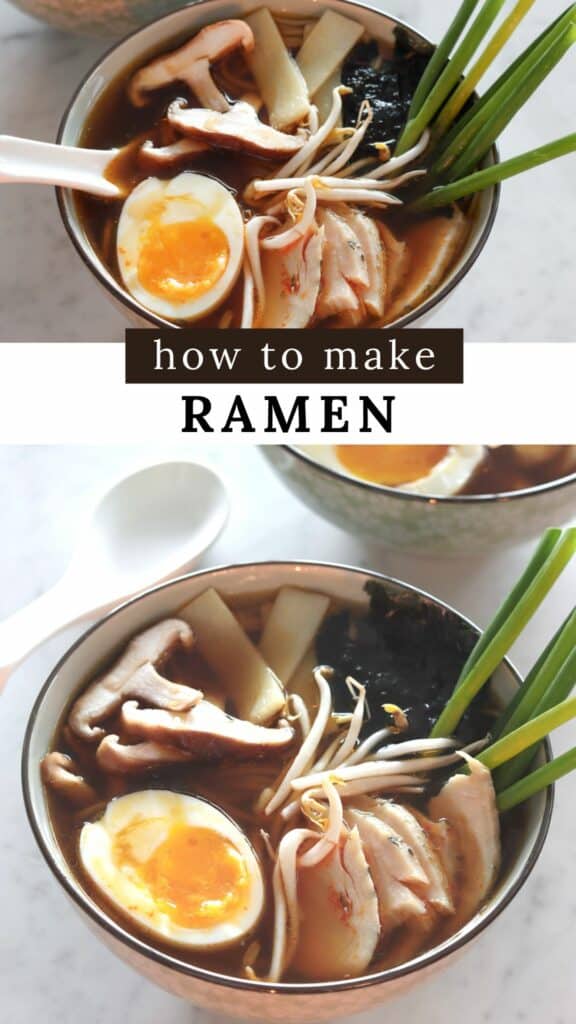




Leave a Reply